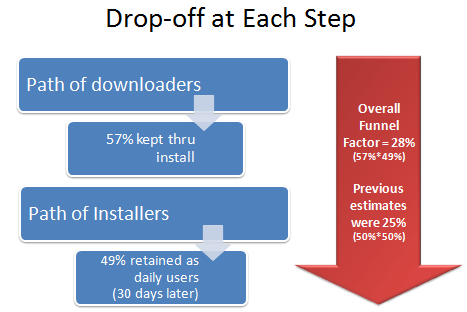As Alex pointed out in our previous funnelcake post, we shipped funnelcake01 on October 4th. While there are a lot of interesting findings that can be extracted from the data, we want to turn our initial focus to something we call a “funnel factor.” In the business world, there is a very basic process by which a customer (which we’ll also refer to as a consumer or user) engages with a provider of goods or services. This process is applicable across industries and across enterprise sizes, i.e., it applies to virtually all companies and their customers.
Here’s a rough outline of the process:
- A consumer makes a decision to purchase (or download) a product or service
- The consumer visits the seller’s store (online or offline)
- The consumer makes a purchase (or download)
- Thereafter, the consumer may or may not use (or install) the product
- Once the consumer uses the product for the first time, he/she then decides each day whether to continue using the product
These are the steps that we set-out to understand.
So, why is funnelcake so unusual, i.e., why is Mozilla’s methodology and openness remarkable in this case?
- Within the steps above, you’ll notice that businesses have historically understood the flow of their customers through the first three or four steps (or between two certain steps), but not across all five steps simultaneously.
- If I walk into a Gap store today and buy a shirt, they won’t know if/when I eventually wear that shirt for the first time, nor will they know how often I eventually wear it over time. Fortunately, the software industry is one arena (among many other industries and examples) providing ripe opportunities for understanding the full spectrum of interactions between a product and its customers.
- Even if other software providers have figured out a way to optimally measure the flow and experience of their customers, I’m not aware of any marketers who have made such findings publicly available.
Thus, for an initial presentation of our findings, we’ve focused on the part of the funnel that has traditionally been most unknown: purchase –> initial use –> long-term use. Translating this path to Firefox creates what we’ve defined as our “funnel factor”: download –> install –> daily active use.
Here’s what we found:

Of those visitors who downloaded Fx, 57% installed the browser. Then of this smaller cohort who installed Fx, 49% continued using it on a daily basis. We’re generating this latter number when looking at usage approx. 30 days after the download and install processes. For those curious, that 49% usage number was 59% after one day and 58% after one week had passed.
Taking these two numbers together and tying the “download –> install –> daily active use” steps together, we then arrive at our funnel factor. In other words, what is the percentage of downloaders who eventually become regular active users? We previously estimated each step as a 50% drop-off, translating to a 25% funnel factor (50%*50%). However, the results of funnelcake show an actual funnel factor of 28% (57%*49%). This means that, of users downloading Firefox, 28% become active daily users.
That sounds like a pretty good retention rate to me. The Firefox community deserves a great deal of congratulations for this type of success.
What are other funnel factors? Perhaps we’ll benefit more in the future as other software providers (or businesses in other industries) come around to being this open about the experiences of their users.
We look forward to continue sharing much more info related to our funnel… please stay tuned.
JT wrote on
:
wrote on
:
Shawn Wilsher wrote on
:
wrote on
:
pd wrote on
:
wrote on
:
Dan wrote on
:
wrote on
:
Andyed wrote on
:
wrote on
:
Pingback from Vista Users Enjoy the Web on Weekends < Blog of Metrics on :
Pingback from Mozilla Comes to the Defense of Radiohead < Blog of Metrics on :
Trackback from open source metrics on :
Pingback from Mozilla Online Advertising – an Experiment < Blog of Metrics on :
Pingback from Mozilla Online Advertising – an Experiment · Get Latest Mozilla Firefox Browsers on :
Pingback from Alanat Coop News » Mozilla’s Firefox usage estimates climb by 15 million since July on :
Pingback from Aproximativ 49 milioane de utilizatori de Firefox • Arena IT - Publicație online de IT&C on :
Pingback from Alanat Coop News » Firefox claims over 125 million active users on :
Pingback from Firefox claims over 125 million active users | Alanat IT News on :
Pingback from Firefox claims over 125 million active users on :
Pingback from Futures News » Firefox claims over 125 million active users on :
Pingback from Business Daily News » Firefox claims over 125 million active users on :
Pingback from Cossacks Breaking News » Firefox claims over 125 million active users on :
Pingback from » Firefox - 125 milioane de utilizatori ? » Blitz - Stiri zilnice din IT, IT&C: tehnologie, internet, telecom, gadgets, jocuri » Stiri IT - Blitz RO on :
Pingback from De l’utilisation de Firefox par 125 millions de personnes | BeFox on :
Jim wrote on
:
wrote on
:
Pingback from Cossacks Breaking News » Mozilla’s Firefox usage estimates climb by 15 million since July on :
Pingback from Firefox Retention < Blog of Metrics on :
Pingback from Firefox Retention · Get Latest Mozilla Firefox Browsers on :
JR wrote on
:
wrote on
:
ak wrote on
:
wrote on
:
Keith wrote on
:
wrote on
:
Hellefleur wrote on
:
wrote on
:
Sanatya wrote on
:
wrote on
:
durruti wrote on
:
wrote on
: